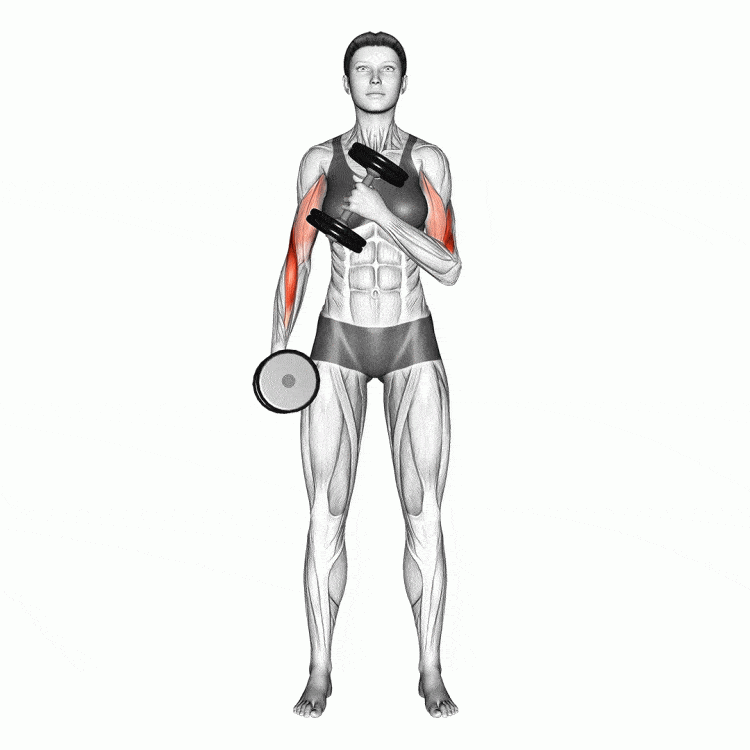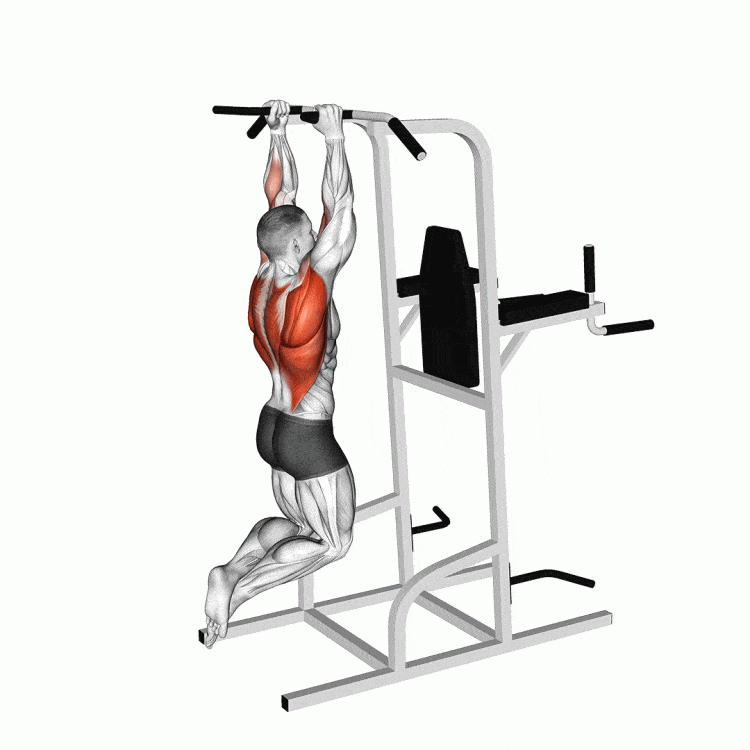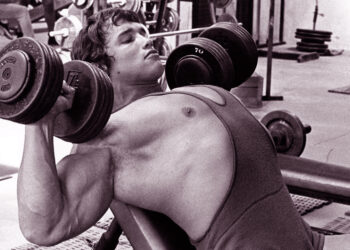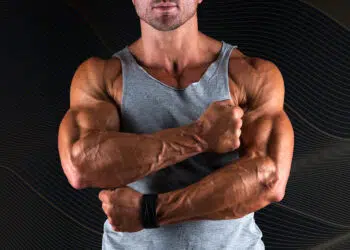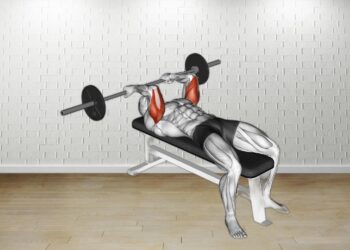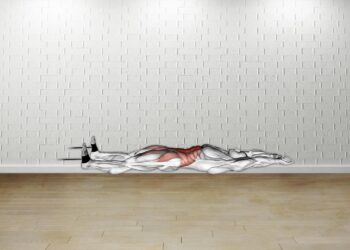The dumbbell cross-body hammer curl is an excellent isolation exercise for the bicep, brachialis, and brachioradialis muscles. Now, this is a great exercise for anyone as it’s very simple to do and the results speak for themselves, so it’s recommended to include this exercise in every arm routine for maximum gains.
But, starting light is highly recommended before progressing to heavier weights with this exercise since the biceps is a vulnerable muscle under heavy resistance loads.
So, make sure to use proper form while training to reap the best results possible.
What is the Cross-Body Hammer Curl?
The cross-body hammer curl is a refined isolation exercise that meticulously targets the elbow flexor muscles nestled within the arms. Traditionally executed using moderate-weight dumbbells, this exercise is emblematic of high-volume sets. However, for those seeking variation or different resistance mechanisms, the cable machine offers an intriguing alternative.
Distinguished from other variations, the cross-body hammer curl is characterized by its neutral grip. This specific positioning accentuates the emphasis on elbow flexion across the complete movement range. The exercise commences with the arms poised gracefully beside the body, culminating with the forearm traversing the expanse of the chest, marking the zenith of the motion.
Level Up Your Fitness: Join our 💪 strong community in Fitness Volt Newsletter. Get daily inspiration, expert-backed workouts, nutrition tips, the latest in strength sports, and the support you need to reach your goals. Subscribe for free!
Anatomy of the Crossbody Hammer Curl
The Target: Brachialis and Brachioradialis
The primary muscles engaged during a crossbody hammer curl are the brachialis and the brachioradialis. The brachialis, positioned beneath the bicep muscle, contributes significantly to the upper arm’s girth when developed. The brachioradialis is a forearm muscle that also gets activated, strengthening and adding definition to the forearm.
Synergists and Stabilizers
While the brachialis and brachioradialis are the prime movers, other muscles such as the biceps brachii and deltoids act as synergists and stabilizers, providing support and balance during the movement.
Technique and Execution
Proper Form and Posture
- Starting Position: Stand upright, holding a dumbbell in each hand with a neutral grip (palms facing inward). Relax your shoulders and keep your elbows close to your torso.
- Execution: Curl one dumbbell towards the opposite shoulder while keeping the other arm stationary. Ensure that the upper arm remains stable and that only the forearm moves.
- Completion: Slowly lower the dumbbell back to the starting position and repeat the movement with the other arm.
Watch how to do the cross-body hammer curl
Tips for Maximizing Efficiency
- Always prioritize form over weight. It’s more beneficial to use lighter weights with perfect form than heavy weights with poor technique.
- Maintain a controlled tempo, avoiding any swift or jerky movements.
- Engage your core to provide stability and protect your lower back.
Benefits of Incorporating the Crossbody Hammer Curl
Enhanced Arm Definition
By working on both the brachialis and the brachioradialis, you get a more sculpted and balanced appearance to the arm.
Functional Strength
This curl translates to real-world functional strength. Whether you’re lifting groceries or performing tasks that require forearm strength, this exercise comes in handy.
Reduced Risk of Overuse Injuries
Diversifying workouts reduces the risk of repetitive strain injuries. The hammer curl variation ensures the entire arm gets attention, not just the biceps.
Avoiding Common Mistakes in the Cross-Body Hammer Curl
The cross-body hammer curl is a staple for targeting the brachialis and brachioradialis. But like many exercises, it’s easy to fall into incorrect patterns. To maximize the benefits and avoid potential injuries, steer clear of these common errors.
1. Leaning with the Torso
The Error: Some lifters, especially when they’re trying to handle heavier weights, unknowingly lean their torso towards the opposite shoulder. This reduces the range of motion and diminishes the exercise’s effectiveness.
The Fix: Stand upright and keep the torso stable. All motion should be restricted to the arm holding the dumbbell.
2. Misaligning the Wrist and Palm
The Error: During the movement, the palm should remain facing inwards, with the wrist neutral. Twisting the arm or adjusting the palm outward can stress the arm joints and misdirect the exercise focus.
The Fix: Consistently check your hand positioning. Ensure your palm faces inward, maintaining a neutral wrist throughout the curl.
3. Relying on Momentum
The Error: A common misstep in various isolation exercises is using momentum. Swinging the torso or the dumbbell decreases the time under tension, crucial for muscle development.
Level Up Your Fitness: Join our 💪 strong community in Fitness Volt Newsletter. Get daily inspiration, expert-backed workouts, nutrition tips, the latest in strength sports, and the support you need to reach your goals. Subscribe for free!
The Fix: Use a controlled motion. If you find yourself using momentum, consider reducing the weight to maintain proper form.
4. Improper Dumbbell Path
The Error: Unlike its standard counterpart, the cross-body hammer curl requires a diagonal, not just vertical, dumbbell movement. A vertical motion can limit the range and possibly strain the shoulder.
The Fix: Always move the dumbbell in an upward and diagonal direction, ensuring you’re maximizing the exercise’s range of motion.
By paying attention to these pointers and being vigilant about your form, you can make the most of the cross-body hammer curl in your workout regimen.
Incorporating Crossbody Hammer Curl in Your Routine
Recommended Sets and Repetitions
For beginners, starting with 3 sets of 12 repetitions per arm is ideal. As you progress, you can increase the weight and adjust repetitions accordingly.
Complementary Exercises
Pairing the crossbody hammer curl with complementary exercises like the standard bicep curl, preacher curls, and concentration curls can result in well-rounded arm development.
Top Alternatives to the Cross-Body Hammer Curl
Enhance your arm workout by exploring effective alternatives to the cross-body hammer curl. These variations promise a diverse range of muscle engagement and cater to various training objectives.
Neutral Grip Pull-Ups
Those who desire a more comprehensive workout might lean towards neutral grip pull-ups. This exercise not only emphasizes the same arm muscles as the cross-body hammer curl but extends its benefits to the back and shoulders.
Hammer Curl Machine
When prioritizing time under tension and wanting to minimize stabilizer muscle involvement, the machine hammer curl is the go-to choice. This exercise offers the familiarity of the traditional hammer curl motion without many of the potential pitfalls linked to free weights.
Zottman Curls
Aiming to maximize muscle mass across the arms? Consider the Zottman curl. This exercise is a fusion of the dumbbell reverse curl and the standard bicep curl. Opting for Zottman curls over cross-body hammer curls shifts the focus from the brachialis to favor greater bicep and forearm engagement.
Frequently Asked Questions
1. Are Cross-Body Hammer Curls Superior to Regular Hammer Curls?
Cross-body hammer curls, with their enhanced range of motion and prolonged time under tension, often edge out the conventional hammer curls. Yet, they might be perceived as less time-efficient since they focus on one arm at a time.
2. What’s the Optimal Hammer Curl Variation?
Your objectives dictate the best version. Machine hammer curls are ideal for extended tension and volume. In contrast, for genuine strength and stability, both cross-body and regular hammer curls excel.
3. Can Hammer Curls Sculpt Impressive Arms?
Absolutely! Hammer curls stimulate the brachialis, biceps, and brachioradialis—key players in forearm and upper arm musculature. When integrated into a robust workout plan, they are instrumental in crafting chiseled, robust arms.
Conclusion
The crossbody hammer curl is not just another variant of the classic bicep curl. It’s an essential workout that targets the oft-neglected brachialis and brachioradialis muscles, promising a comprehensive arm workout. By maintaining proper form and integrating it into your routine, you’re ensuring balanced arm development, both in aesthetics an
Interested in measuring your progress? Check out our strength standards for Pull Ups, Preacher Curl, Hammer Curl, and more.

